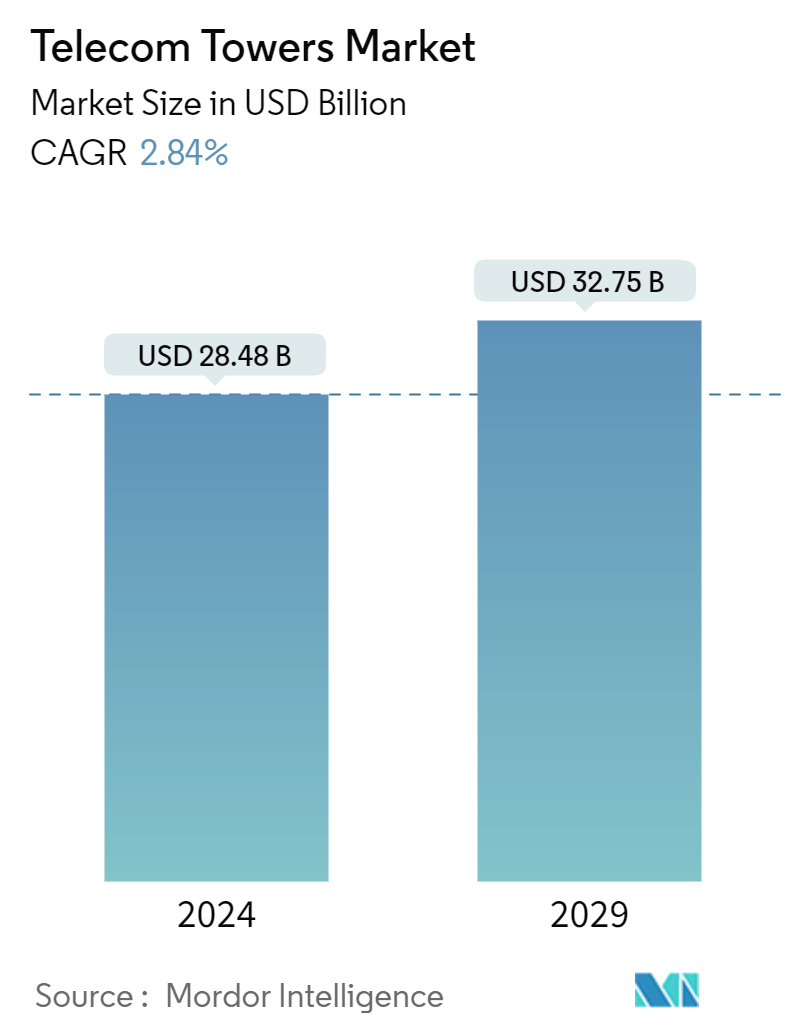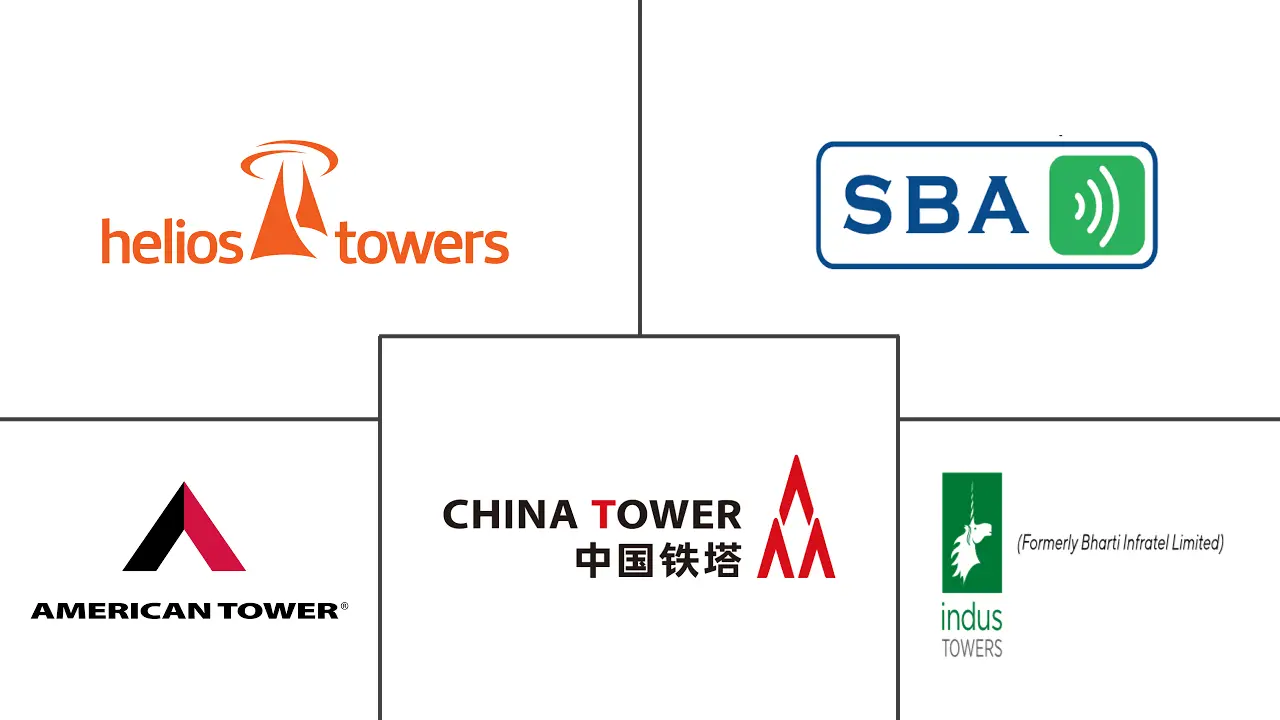Market Size of Telecom Towers Industry

| Study Period | 2019 - 2029 |
| Market Size (2024) | USD 28.48 Billion |
| Market Size (2029) | USD 32.75 Billion |
| CAGR (2024 - 2029) | 2.84 % |
| Fastest Growing Market | Asia Pacific |
| Largest Market | Middle East and Africa |
| Market Concentration | Medium |
Major Players
*Disclaimer: Major Players sorted in no particular order |
Telecom Towers Market Analysis
The Telecom Towers Market size is estimated at USD 28.48 billion in 2024, and is expected to reach USD 32.75 billion by 2029, growing at a CAGR of 2.84% during the forecast period (2024-2029).
The increasing penetration of high-speed internet services globally and the sharp rise in the number of smartphone and smart device users worldwide are some of the key driving factors expected to affect the growth trajectory of the global telecom tower market in the next years.
- Telecom towers are crucial in the 5G technology because telecom companies are learning that sharing and/or lending infrastructure is less expensive than starting from scratch, and tower businesses may provide the best bargains. Towercos are regaining importance as 5G networks' advantages necessitate a vast amount of additional infrastructure. This indicates that mobile network operators need to modernize, and investors are eager to identify fresh chances that could result in rapid returns in the 5G stock market.
- Moreover, tower businesses now have more opportunities for growth due to smart cities, and many of them are aiming to provide end-to-end communications infrastructure in the chosen cities. Towercos can provide various options for smart cities, including passive infrastructure, small cells, Wi-Fi, and fiber connectivity. Smart poles, which guarantee improved cellular coverage and enhance aesthetic value, have already begun to be installed by many tower firms. These poles can be leased to network operators and the government to install surveillance and traffic management systems and offer Wi-Fi and smart lighting services.
- The increasing emphasis on improving internet connectivity to rural areas is one of the major factors driving the deployment and improvisation of the telecom infrastructure in these areas, thereby aiding the market's growth.
- Telecom towers require an uninterrupted power supply to ensure 24x7 network availability, fulfilled mainly by electricity, batteries, and diesel generators. The environmental impacts of telecom towers have always been a significant concern. Radiation from mobile towers has been an important issue, and it is recognized as an unseen and subtle pollutant affecting life forms in multiple ways. Moreover, using non-renewable sources to run power systems, such as diesel, significantly pollutes the environment.
- With things returning to normalcy, the construction activities are set to return on track again. Overall, the telecom industry was among the major industries that experienced minimal impact from the COVID-19 pandemic. The primary region behind this was the significant increase in consumption of telecommunication services as more people started working from home and reliance on video conferencing to hold meetings increased. Most of the telecom operators in the region have reported an increase in their revenue due to this.
Telecom Towers Industry Segmentation
A telecommunication tower can be of any structure, including monopoles, tripoles, lattice towers, guyed towers, self-support towers, poles, masts, or similar structures. These towers support one or more telecommunication antennas, allowing radio communications. They can be placed on the ground or a building's rooftop, including equipment storage and storing electronic components. These towers do not require regular staffing and require periodic maintenance. The growth of telecom towers is set to continue during the forecast period, owing to the deployment of 5G infrastructure.
The telecom towers market is segmented by fuel type (renewable and non-renewable), type of tower (lattice tower, guyed tower, monopole tower, and stealth tower), installation (rooftop and ground-based), ownership (operator-owned, joint venture, private-owned, MNO captive), and geography (North America [United States and Canada], Europe (United Kingdom, Germany, France, Italy, Spain, Netherlands, Sweden, Switzerland, and Rest of Europe], Asia-Pacific [China, India, Japan, South Korea, Indonesia, Vietnam, Malaysia, Philippines, Australia and New Zealand, and Rest of Asia-Pacific], Latin America [Brazil, Mexico, Argentina, Central America, Columbia, and Rest of Latin America], and Middle East and Africa [Saudi Arabia, Egypt, Algeria, Nigeria, South Africa, Tanzania, Morocco, and Rest of Middle East and Africa]). The market sizes and forecasts are provided in terms of value (USD) for all the above segments.
| By Fuel Type | |
| Renewable | |
| Non-renewable |
| By Type of Tower | |
| Lattice Tower | |
| Guyed Tower | |
| Monopole Towers | |
| Stealth Towers |
| By Installation | |
| Rooftop | |
| Ground-based |
| By Ownership | |
| Operator-owned | |
| Joint Venture | |
| Private-owned | |
| MNO Captive |
| By Geography | ||||||||||||
| ||||||||||||
| ||||||||||||
| ||||||||||||
| ||||||||||||
|
Telecom Towers Market Size Summary
The telecom tower market is poised for steady growth over the forecast period, driven by the increasing global demand for high-speed internet and the proliferation of smartphones and smart devices. Telecom towers play a pivotal role in the deployment of 5G technology, as sharing and leasing infrastructure proves more cost-effective for telecom companies. This trend is further bolstered by the need for extensive infrastructure to support the advantages of 5G networks. The market is also witnessing opportunities from the development of smart cities, where tower companies are expanding their offerings to include passive infrastructure, small cells, Wi-Fi, and fiber connectivity. The emphasis on enhancing internet connectivity in rural areas is another significant factor contributing to the market's expansion, as telecom infrastructure is deployed and upgraded to meet these needs.
The market landscape is semi-consolidated, with major players like American Tower Corporation, Helios Towers PLC, and Indus Towers Limited dominating the scene. These companies are expanding their international presence through strategic collaborations and acquisitions, leading to a moderately high market concentration. Recent partnerships, such as those between American Tower Corporation and IBM, and AT&T Inc. with Ericsson, highlight the industry's focus on integrating advanced technologies like IoT, 5G, and AI to drive digital transformation. Additionally, initiatives in regions like Saudi Arabia and Egypt, supported by government policies and investments, are fostering the growth of telecom towers. The market is also seeing significant investments in rural infrastructure, as evidenced by TowerCo. of Africa Uganda's efforts to expand coverage in underserved areas.
Telecom Towers Market Size - Table of Contents
-
1. MARKET INSIGHTS
-
1.1 Market Overview
-
1.2 Industry Attractiveness - Porter's Five Forces Analysis
-
1.2.1 Bargaining Power of Suppliers
-
1.2.2 Bargaining Power of Buyers
-
1.2.3 Threat of New Entrants
-
1.2.4 Threat of Substitutes
-
1.2.5 Intensity of Competitive Rivalry
-
-
-
2. MARKET SEGMENTATION
-
2.1 By Fuel Type
-
2.1.1 Renewable
-
2.1.2 Non-renewable
-
-
2.2 By Type of Tower
-
2.2.1 Lattice Tower
-
2.2.2 Guyed Tower
-
2.2.3 Monopole Towers
-
2.2.4 Stealth Towers
-
-
2.3 By Installation
-
2.3.1 Rooftop
-
2.3.2 Ground-based
-
-
2.4 By Ownership
-
2.4.1 Operator-owned
-
2.4.2 Joint Venture
-
2.4.3 Private-owned
-
2.4.4 MNO Captive
-
-
2.5 By Geography
-
2.5.1 North America
-
2.5.1.1 United States
-
2.5.1.2 Canada
-
-
2.5.2 Europe
-
2.5.2.1 United Kingdom
-
2.5.2.2 Germany
-
2.5.2.3 France
-
2.5.2.4 Italy
-
2.5.2.5 Spain
-
2.5.2.6 Netherlands
-
2.5.2.7 Sweden
-
2.5.2.8 Switzerland
-
2.5.2.9 Rest of Europe
-
-
2.5.3 Asia-Pacific
-
2.5.3.1 China
-
2.5.3.2 India
-
2.5.3.3 Japan
-
2.5.3.4 South Korea
-
2.5.3.5 Indonesia
-
2.5.3.6 Vietnam
-
2.5.3.7 Malaysia
-
2.5.3.8 Philippines
-
2.5.3.9 Australia and New Zealand
-
2.5.3.10 Rest of Asia-Pacific
-
-
2.5.4 Latin America
-
2.5.4.1 Brazil
-
2.5.4.2 Mexico
-
2.5.4.3 Argentina
-
2.5.4.4 Rest of Latin America
-
-
2.5.5 Middle East and Africa
-
2.5.5.1 Saudi Arabia
-
2.5.5.2 Egypt
-
2.5.5.3 Algeria
-
2.5.5.4 Nigeria
-
2.5.5.5 South Africa
-
2.5.5.6 Tanzania
-
2.5.5.7 Morocco
-
2.5.5.8 Rest of Middle East and Africa
-
-
-
Telecom Towers Market Size FAQs
How big is the Telecom Towers Market?
The Telecom Towers Market size is expected to reach USD 28.48 billion in 2024 and grow at a CAGR of 2.84% to reach USD 32.75 billion by 2029.
What is the current Telecom Towers Market size?
In 2024, the Telecom Towers Market size is expected to reach USD 28.48 billion.

